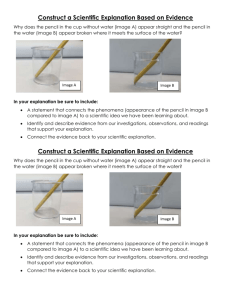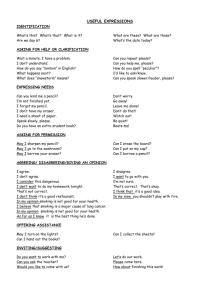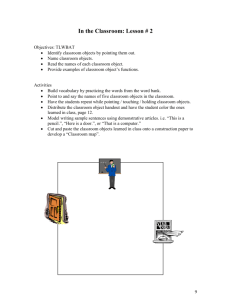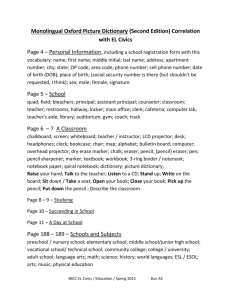PSY101: Practice Test #1 1. You have been assigned to write a
advertisement
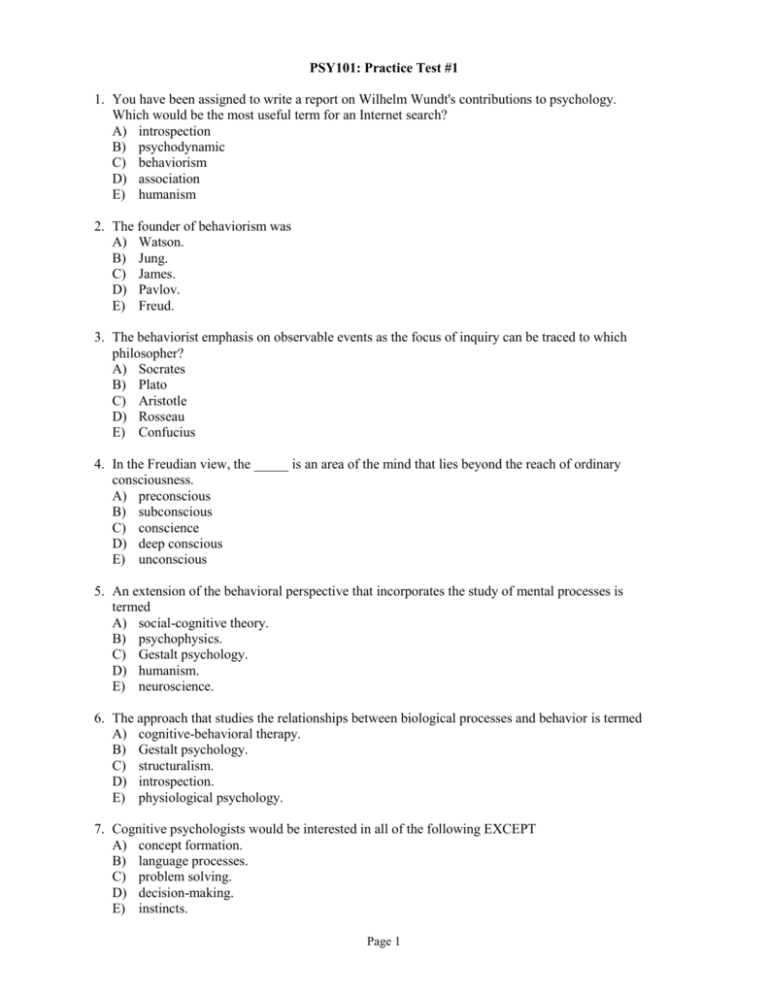
PSY101: Practice Test #1 1. You have been assigned to write a report on Wilhelm Wundt's contributions to psychology. Which would be the most useful term for an Internet search? A) introspection B) psychodynamic C) behaviorism D) association E) humanism 2. The founder of behaviorism was A) Watson. B) Jung. C) James. D) Pavlov. E) Freud. 3. The behaviorist emphasis on observable events as the focus of inquiry can be traced to which philosopher? A) Socrates B) Plato C) Aristotle D) Rosseau E) Confucius 4. In the Freudian view, the _____ is an area of the mind that lies beyond the reach of ordinary consciousness. A) preconscious B) subconscious C) conscience D) deep conscious E) unconscious 5. An extension of the behavioral perspective that incorporates the study of mental processes is termed A) social-cognitive theory. B) psychophysics. C) Gestalt psychology. D) humanism. E) neuroscience. 6. The approach that studies the relationships between biological processes and behavior is termed A) cognitive-behavioral therapy. B) Gestalt psychology. C) structuralism. D) introspection. E) physiological psychology. 7. Cognitive psychologists would be interested in all of the following EXCEPT A) concept formation. B) language processes. C) problem solving. D) decision-making. E) instincts. Page 1 8. The sociocultural perspective emphasizes the roles of all but which of the following in understanding behavior and mental processes? A) income level B) individual personality differences C) gender D) culture E) ethnicity 9. Dr. Sears gives a lecture on positive psychology. Which psychologist's work will she be most likely to highlight in her lecture? A) Abraham Maslow B) William James C) Martin Seligman D) John B. Watson E) Carl Rogers 10. A humanist would give which explanation for aggression? A) Brain abnormalities explain violent behavior is some people. B) Social conditions give rise to drug use that, in turn, causes aggressive behavior. C) Aggression results from unconscious impulses. D) Aggression increases when people become frustrated by not being able to meet their goals. E) Aggression is learned through observing others and through reinforcement. 11. Most psychologists A) teach at colleges and universities. B) work for business and industry. C) work for the government. D) engage in laboratory research. E) provide psychological services. 12. What is the most common doctoral degree awarded in the field of psychology? A) Ph.D. B) Psy.D. C) M.A. D) Ed.D. E) B.A. 13. A school psychologist would be most likely to A) help teachers develop new instructional techniques. B) study how groups affect individuals. C) administer an intelligence test to a twelve-year-old child. D) make suggestions as to how managers could improve employee morale. E) investigate the relationship between childhood obesity and self-esteem. 14. Caroline Sherry is a counseling psychologist. Which of the following is she least likely to see as a client? A) Mr. Andrew has generalized anxiety disorder. B) Mr. and Mrs. Babette have marital problems. C) Ms. Conchetta, a college student, is confused about choosing a college major. D) Mr. Drew is a non-traditional student having difficulties adjusting to college after being unemployed. E) Ms. Evans and her teenage daughter have communication problems. Page 2 15. Which type of psychologist would be interested in memory loss in elderly individuals? A) social psychologist B) health psychologist C) counseling psychologist D) forensic psychologist E) geropsychologist 16. The ethical code of psychologists is based on all but which of the following ideas? A) People have a basic right to make their own decisions. B) Research participants or clients must not be harmed. C) People's dignity and welfare must be respected. D) People have a basic right to exercise choice. E) Determination of ultimate truth outweighs individual cost. 17. Every participant in an experiment has an equal chance of receiving one of the treatments. This is called A) control assignment. B) random selection. C) a placebo effect. D) random assignment. E) control selection. 18. You see a journal article entitled, “Injection of Happystuff causes a reduction in symptoms of depression in adult males”. This tells you that the independent variable A) is Happystuff. B) is symptoms of depression. C) is adult males. D) is depression. E) cannot be determined. 19. Which of the following definitions best describes “independent variable”? A) a research method that examines relationships between factors B) effects or outcomes of an experimental manipulation C) an inert substance or condition that resembles the treatment D) a statistical measure of association between two factors E) factors manipulated in an experiment 20. The component of a neuron that performs metabolic functions of the cell is called the A) soma. B) axon. C) terminal button. D) synapse. E) dendrite. 21. Which of the following is the best describes a synapse? A) a tiny gap that separates one neuron from another B) the tubelike part of a neuron that carries messages to other neurons C) rootlike structures that receive neural impulses from other neurons D) body organs or structures that produce secretions E) a bundle of axons from different neurons that transmit nerve impulses Page 3 22. What is the job of a dendrite? A) to send signals to other neurons B) to receive signals from other neurons C) to synthesize neurotransmitters D) to control metabolic functions E) to generate action potentials 23. In neurons, efferent is to ______ as afferent is to ______. A) sensory / motor B) motor / sensory C) motor / interneuron D) interneuron / sensory E) sensory / interneuron 24. The resting potential of a neuron is a result of A) high concentration of sodium ions outside the cell. B) high concentration of sodium ions inside the cell. C) low concentration of potassium ions outside the cell. D) high concentration of potassium ions inside the cell. E) low concentration of chloride ions inside the cell. 25. Agonists do all of the following EXCEPT A) increase production of neurotransmitters. B) increase release of neurotransmitters. C) stimulate receptor sites. D) mimic the action of neurotransmitters. E) block receptor sites. 26. Cocaine and amphetamines increase the availability of A) glutamate. B) serotonin. C) acetylcholine. D) dopamine. E) GABA. 27. In the cerebral cortex, ______ is to vision as ______ is to hearing. A) occipital / parietal B) temporal / frontal C) frontal / parietal D) parietal / temporal E) occipital / temporal 28. Which technique takes snapshots of the brain in action? A) computed tomography B) electroencephalography C) CT scan D) magnetic resonance imagery E) functional magnetic resonance imagery Page 4 29. Who was a pioneer in the discovery of the language areas of the brain? A) Roger Sperry B) Michael Gazzaniga C) Phineas Gage D) Oliver Sacks E) Paul Broca 30. In a split-brain research study, what will happen when a pencil is presented in the patient's visual field? A) The patient will be able to pick out the pencil from a group of objects, but not be able to say “pencil” regardless of which visual field the pencil is presented to. B) The patient will be able to say “pencil,” but will not be able to pick out pencil from a group of objects regardless of which visual field the pencil is presented to. C) The patient will be able to say “pencil” when the pencil is presented to the right visual field, but not when presented to the left visual field. D) The patient will be able to say “pencil” when the pencil is presented to the left visual field, but not when presented to the right visual field. E) The patient will be able to pick out the pencil from a group of objects but not able to say “pencil” when the pencil is presented to the right visual field. 31. Alcohol increases the sensitivity of receptor sites for A) glutamate. B) GABA. C) serotonin. D) endorphins. E) dopamine. 32. Which hormone regulates the amount of sugar in the blood? A) noradrenaline B) insulin C) adrenaline D) glucose E) oxytocin 33. Somatosensory information is processed by which lobe? A) occipital B) frontal C) temporal D) parietal E) reticulartal 34. The fact that alcohol often causes problems with balance and coordination suggests that it may have an effect on the A) cerebrum. B) corpus callosum. C) cerebellum. D) thalamus. E) reticular formation. Page 5 35. Your heartbeat, digestion, and pupil contractions are ______ processes regulated by the ______ nervous system. A) involuntary / somatic B) involuntary / autonomic C) controllable / somatic D) voluntary / somatic E) voluntary / autonomic 36. The peripheral nervous system connects the spinal cord and brain with the A) sensory organs and muscles. B) sensory organs and glands. C) muscles and glands. D) the sensory organs, glands, and muscles. E) muscles. 37. Which of the following is NOT part of the hindbrain? A) cerebellum B) reticular formation C) medulla D) pons E) brainstem core 38. The smallest amount of a stimulus that a person can reliably detect is called the A) absolute threshold. B) difference threshold. C) just-noticeable difference. D) just-noticeable threshold. E) constant. 39. Another name for the difference threshold is the A) just-noticeable difference. B) perceptual threshold. C) sensitivity threshold. D) threshold of difference detection. E) law of Weber. 40. According to Weber's Law, people are most sensitive to changes in which sensation? A) the loudness of sounds B) the heaviness of weight C) the saltiness of food D) brightness of lights E) the pitch of sounds 41. If you are expecting a telephone call, you may be more likely to notice the telephone ringing while you are in the shower than if you were not expecting a call. This example is an illustration of A) signal-detection theory. B) Weber's law. C) sensory adaptation. D) opponent-process theory. E) dual-process theory. Page 6 42. The muscle which regulates the amount of light entering the eye is the A) lens. B) cornea. C) pupil. D) iris. E) fovea. 43. In vision, the photoreceptors are called A) retina, lens and pupil. B) hair-cell receptors. C) semicircular canals and vestibular sacs. D) pheromones. E) rods and cones. 44. To see a dimly lit object at night, the image must fall on your A) fovea. B) blind spot. C) cones. D) rods. E) optic nerve. 45. For the sharpest vision, the image of an object should be focused on the A) fovea. B) blind spot. C) optic chiasm. D) optic nerve. E) retina. 46. Negative afterimages provide support for which theory of color vision? A) trichromatic theory B) feature detection theory C) color constancy theory D) feature detection theory E) opponent-process theory 47. People who only see in black and white are called A) monochromats. B) dichromats. C) trichromats. D) unichromats. E) partially color-blind. 48. All but which of the following are suggested by opponent-process theory? A) Black-white photoreceptors are responsible for detecting differences in brightness. B) Continually staring at a green image will result in an afterimage of red. C) Continually staring at a yellow image will result in an afterimage of blue. D) Red-green receptors simultaneously transmit messages for red and green. E) Eyes have three pairs of color receptors. Page 7 49. Which of the following best describes the organ of Corti? A) auditory receptor that transforms vibration of sound waves into neural impulses B) a gelatinous structure in the cochlea that contains the auditory receptors C) a sheet of connective tissue separating the outer ear from the middle ear D) a shell-shaped organ in the inner ear that contains sensory receptors for hearing E) a collection of tiny bones in the middle ear that vibrate in response to vibrations from the eardrum 50. High-frequency sounds cause the greatest vibration of A) hair cells in the middle of the basilar membrane. B) hair cells nearest the oval window. C) hair cells nearest the auditory nerve. D) hair cells farthest down the basilar membrane from the oval window. E) the membrane of the eardrum. 51. Olfaction refers to one's sense of A) taste. B) touch. C) seeing. D) hearing. E) smell. 52. All of the following senses go through the thalamus on the way to the cortex EXCEPT A) vision. B) smell. C) hearing. D) taste. E) touch. 53. Pheromones play a role in which of the following animal behaviors? A) mate attraction B) territorial marking C) aggression D) organization of food-gathering efforts E) all of the above 54. Compared to people with average taste sensitivity, people who are "supertasters" have A) different types of taste buds. B) more sensitive taste buds. C) a very dense network of taste buds. D) bigger taste buds. E) fewer specialized taste buds. 55. Sensations of hotness result from A) stimulation of hot receptors. B) stimulation of warm receptors. C) stimulation of cold receptors. D) simultaneous stimulation of warm and cold receptors. E) stimulation of pain receptors. Page 8 56. In response to pain, the brain signals the release of A) dopamine. B) acetylcholine. C) endorphins. D) norepinephrine. E) serotonin. 57. According to the carpentered-world hypothesis, people living in cultures in which right-angled structures are rare are less prone to which visual illusion? A) Muller-Lyer illusion B) Ponzo illusion C) moon illusion D) railroad illusion E) stroboscopic illusion 58. ______ is a process of focused attention that induces a relaxed mental and physical state. A) Biofeedback B) Meditation C) Bottlenecking D) Telepathy E) The Ganzfeld procedure 59. The vestibular apparatus includes A) the semicircular canals only. B) the vestibular sacs only. C) the olfactory receptors only. D) both the semicircular canals and the vestibular sacs. E) both the olfactory receptors and the vestibular sacs. 60. Even though two lines are of equal length, the one with outward pointing wings looks longer than the one with inward pointing wings. This is an example of the A) Ponzo illusion. B) interposition illusion. C) Muller-Lyer illusion. D) texture gradient illusion. E) phi phenomenon. 61. Brenda only has one eye. Which of the following depth cues is she unable to use? A) relative size B) retinal disparity C) interposition D) texture gradient E) continuity 62. Tony observes an oval bowl on a table from several different perspectives. Although the image on his retina changes, he continues to perceive the bowl as oval. Tony's experience is an example of ______ constancy. A) brightness B) textural gradience C) size D) interpositional E) shape Page 9 Answer Key 1. 2. 3. 4. 5. 6. 7. 8. 9. 10. 11. 12. 13. 14. 15. 16. 17. 18. 19. 20. 21. 22. 23. 24. 25. 26. 27. 28. 29. 30. 31. 32. 33. 34. 35. 36. A A C E A E E B C D E A C A E E D A E A A B B A E D E E E C B B D C B D 38. 39. 40. 41. 42. 43. 44. 45. 46. 47. 48. 49. 50. 51. 52. 53. 54. 55. 56. 57. 58. 59. 60. 61. 62. A A E A D E D A E A D B B E B E C D C A B D C B E 37. B Page 10


